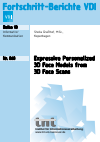Zusammenfassung
In this work, different methods are presented to create 3D face models from databases of 3D face scans. The challenge in this endeavour is to balance the limited training data with the high demands of various applications.
The 3D scans stem from various persons showing different expressions, with varying number of points per 3D scan and different numbers of scans per person. This data of posed facial expressions revealed substructures, which are utilised to improve the proposed model. In the process of creating and using the models, for each specifc application objective quality criteria are carefully designed tailored to the task to quantify the quality.
In total four face models built from three databases are compared based on: 3D face synthesis, 3D approximation, person and expression transfer, and 3D reconstruction from 2D.
Contents
Abbreviations and Nomenclature
XII
1 Introduction
1
1.1 The Difficulty of Quality Assessment . . . . . . . . . . . . . . 2
1.2 Face Models ....
Schlagworte
Informatik Kommunikation 3D-Gesichts-Scan nicht-rigide Registrierung Korrespondenzschätzung Intensität von Gesichtsausdrücken Tensor statistische Modelle Transfer von Gesichtsausdrücken 3D-Rekonstruktion 3D face scans nonrigid registration correspondence estimation expression intensity tensor factorization statistical models.expression transfer 3D reconstruction TNT Universität Hannover- Kapitel Ausklappen | EinklappenSeiten
- 1–14 1 Introduction 1–14
- 15–39 2 Fundamentals 15–39
- 40–58 3 Face Databases 40–58
- 114–145 5 Face Models 114–145
- 146–173 6 Experiments 146–173
- 179–188 Appendix 179–188
- 189–198 Literature 189–198
- 199–204 Index 199–204

